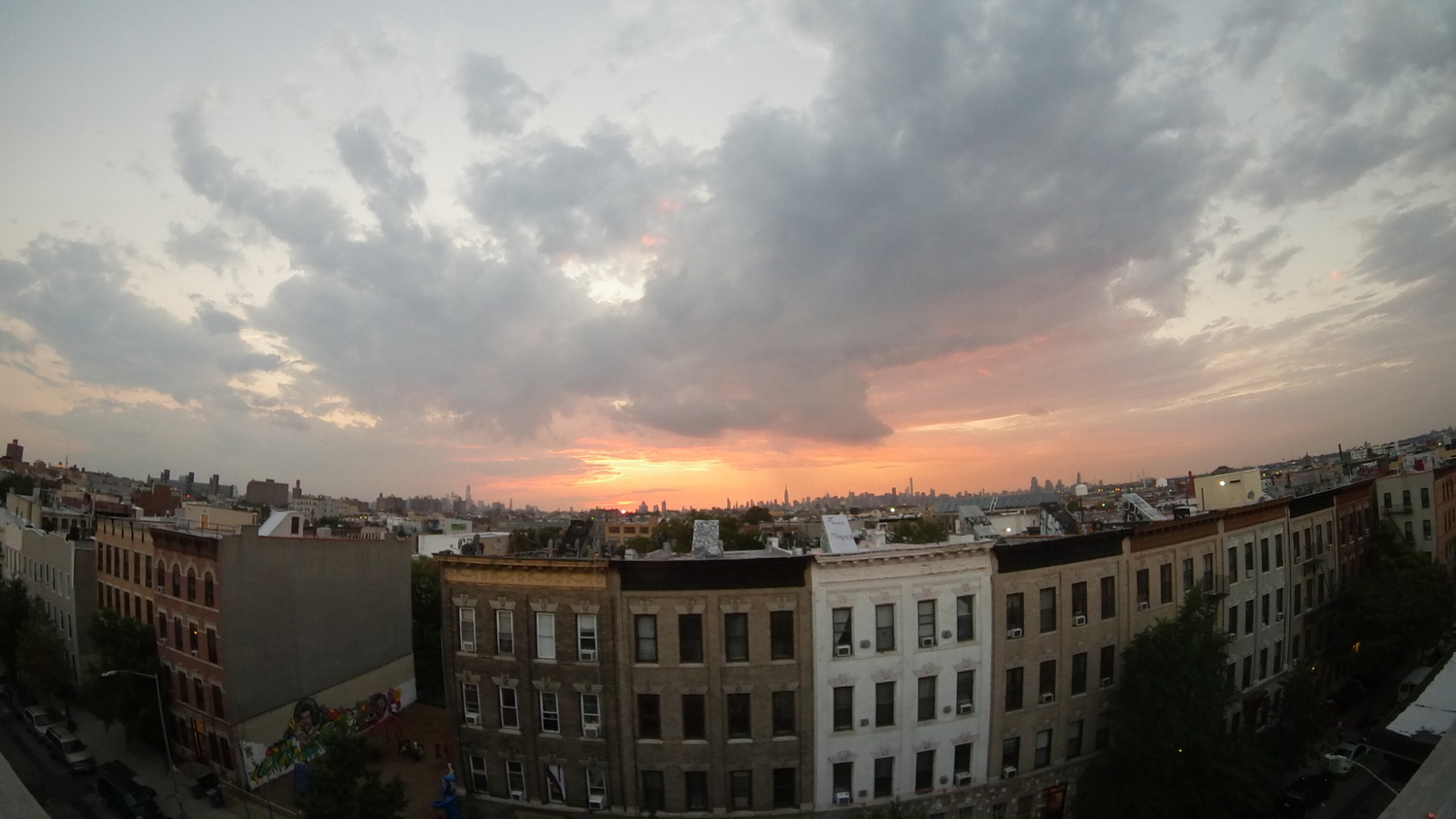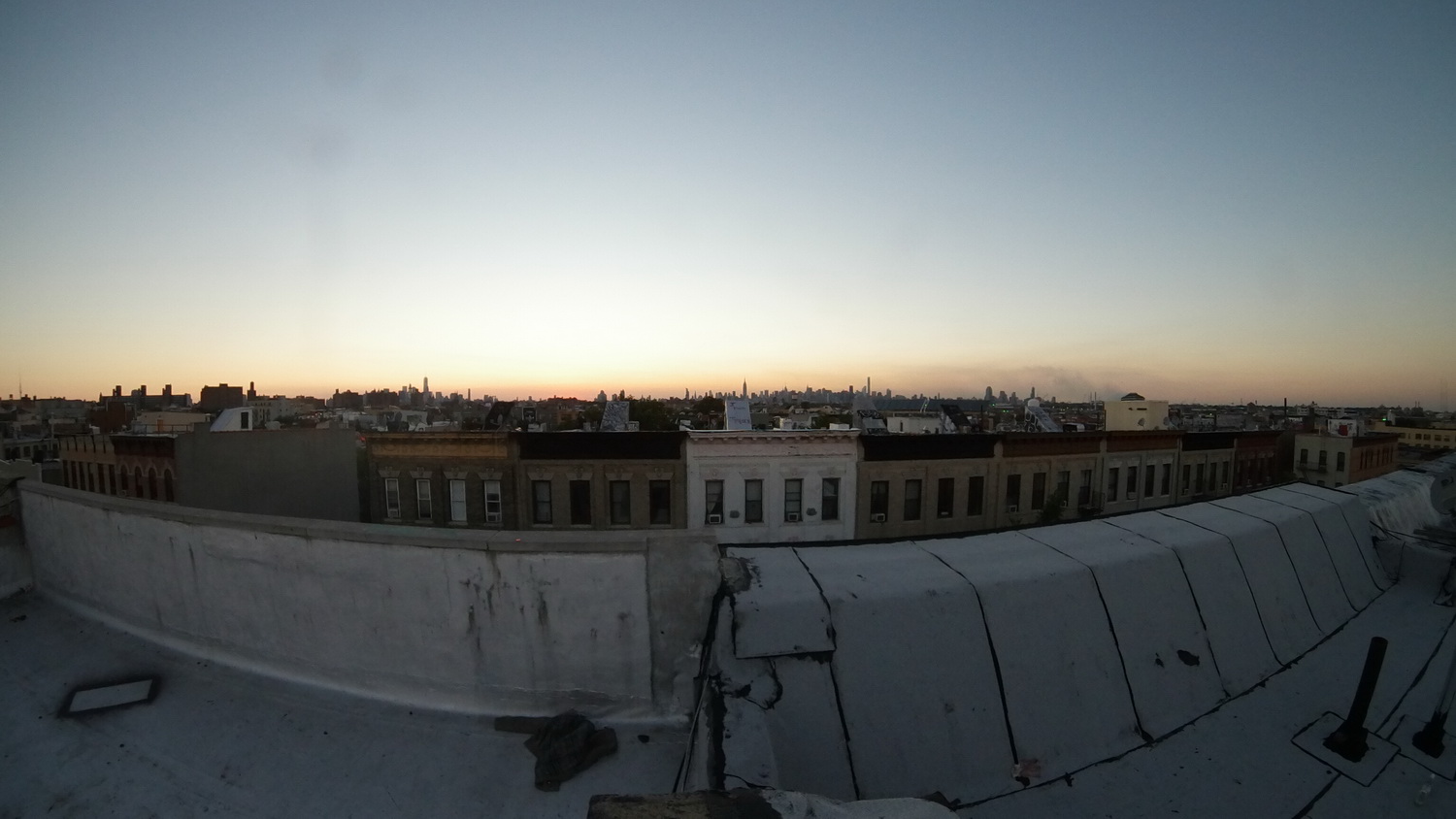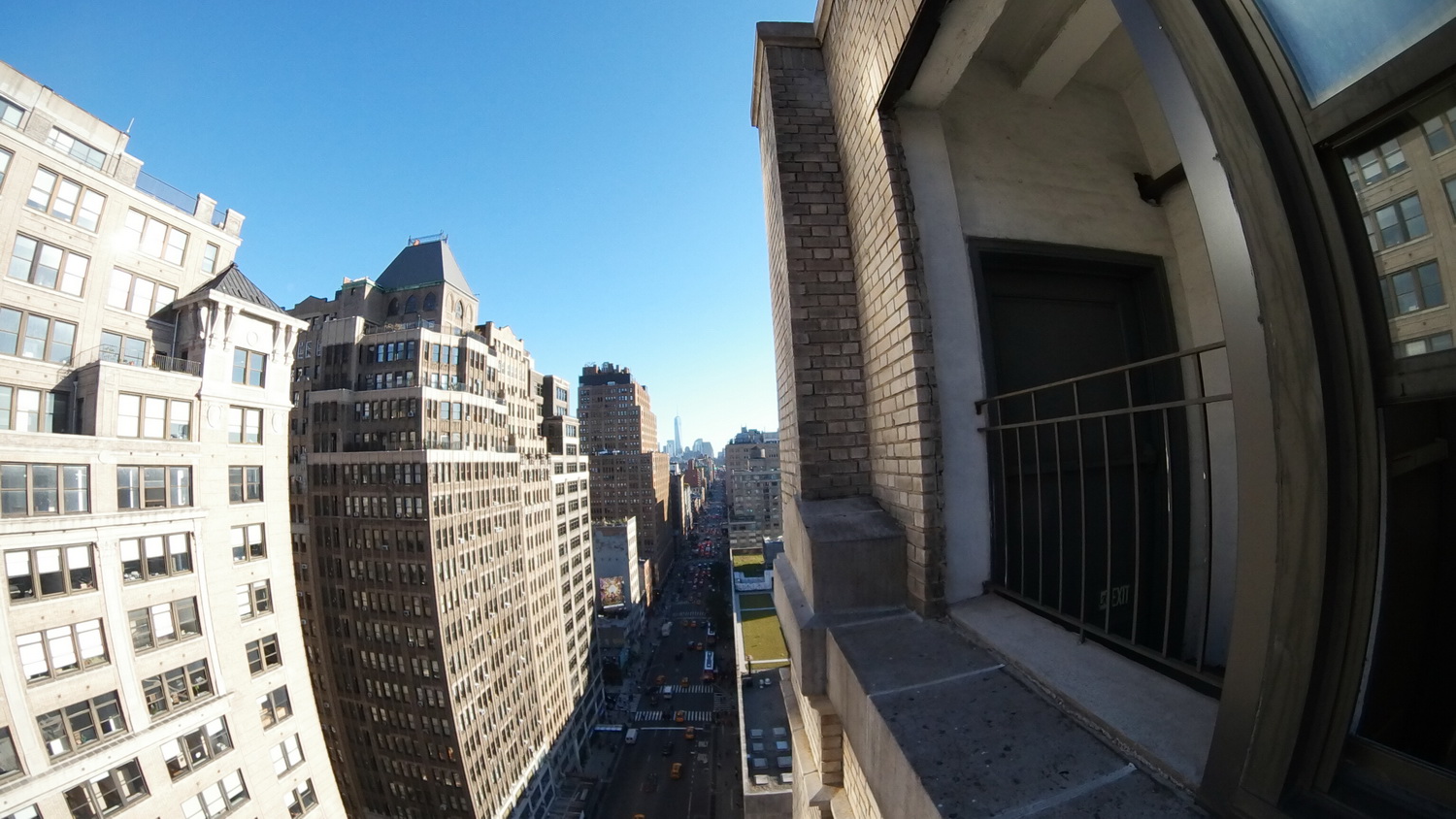“Samsung’s Gear 360 is the best 360 cam for Galaxy owners.”
- Works seamlessly with S7/S7 Edge, Gear VR
- Captures good-quality 360-degree photos, videos
- Bright f/2 lens
- Solid, water-resistant construction
- Easy to use
- Only works with select Samsung phones
- Misaligned stitching
- Hefty, awkwardly round
Samsung is a leader in virtual reality. The company is already on its second version of the Gear VR headset – viewing goggles that let you experience immersive 360-degree content with select Samsung phones. 360-degree cameras allow anyone to become content creators, and one good option — the Samsung Gear 360 — comes from the Galaxy manufacturer. Now Gear VR owners won’t just get to watch content, they can now film it, too.
The original Gear 360 ($350, available August 19) camera is the third piece of the Galaxy VR trifecta – the phone plays content, the headset lets you view it, and now the camera lets you create it. Samsung has engineered a solid camera that works really well with the Gear VR and Galaxy Note 7/Galaxy S7/S7 Edge series – so well that it’s almost seamless. But in perfecting this synergy, Samsung has made the Gear 360 useless if you aren’t a Galaxy 7 owner.
Note: This is a review of the original Samsung Gear 360, which was been replaced by a new model with the same name. Our Gear 360 (2017) review shows a model that improves upon the original in many ways, including wider support for mobile devices, 4K, and live-streaming (although it still has the quirks that comes with nascent technology). Although you can still find the original Gear 360 for approximately $150 (street), we recommend you take a pass and opt for the new version instead. That said, our original review is below.
Design, specs, and features
Nothing about the Gear 360 has changed since our hands-on time during Mobile World Congress. The round camera is roughly the size of a billiard ball, and, at 5.4 ounces, weighs the same too. In our first-impression, we thought the camera would be easy to carry, and while that remains mostly the case, it does have a bit of heft. It is an ounce heavier than Ricoh’s Theta S and twice the weight of LG’s 360 Cam.
The camera looks like a large eyeball that our hands-on reviewer deemed cute. The camera isn’t a perfect sphere, due to the covers over the two lenses that protrude out slightly – similar to any small camera with fish-eye lenses. Each fish-eye lens can independently shoot a 195-degree wide-angle field-of-view (like an action cam), or a 360-degree image when the two are used simultaneously. Each lens has a bright f/2.0 aperture, which in theory would give it better low-light performance; in comparison, the Theta S lenses also have an f/2.0 aperture, while the 360 Cam’s have an even brighter f/1.8.
It’s hard to differentiate, but the lenses are actually designated as front and rear. The front lens is the one that’s adjacent to the small status LCD that shows mode (video, photo, video loop, and time-lapse) remaining storage capacity, battery life, and Bluetooth on/off. On both sides of the front lens are two pinhole microphones; near the rear lens are a speaker and an NFC tag. At the top is the shutter butter. On one side you’ll find the Bluetooth/Menu and Power/Back buttons, and on the other side is a compartment for the removable battery (1,350mAh), Micro SD card slot (support for up to 128GB), and Micro USB port. While the battery has a small capacity, you can easily swap it out for a fresh one, which you can’t do with LG and Ricoh’s cameras.
Compared to the Theta S and 360 Cam, which opt for slim profiles that make them easy to hold, the Gear 360 went for a bulbous design, which is why Samsung includes a mini tripod that screws into the bottom of the camera. With the legs folded, it doubles as a grip. You can hold the camera with your fingers or set it on a surface. However, during testing we found we preferred using larger handheld tripods (we used the Manfrotto Pixi and the PolarPro Trippler) that provide a firmer grip. If you’re shooting a room for, say, real-estate purposes, you may want to use a full tripod, as keeping it stationary will help it capture sharper photos, while allowing you to place the camera much higher above ground. Still, a tripod is a nice inclusion.
Inside the camera are two 15-megapixel 1/2.3-inch CMOS sensors capable of recording a 360-degree video with an almost-4K resolution of 3,840 x 1,920 pixels at 30 frames per second (fps); in single camera mode the Gear 360 shoots video at 2,560 x 1,440. Spherical still photos are taken at 30 megapixels (7,776 x 3,888) when in dual-camera mode, but 5 megapixels (3,072 x 1,728) in single-camera mode.
The Gear 360 is constructed well. A benefit is that it carries an IP5 rating for dust and water resistance. No, it’s not waterproof (i.e., don’t swim with it), but a light splash of water from the pool or rain shouldn’t hurt it.
Comfortable, but awkward
The form-factor makes it difficult to place inside clothing pockets. Even if you manage to shove it into a coat pocket, the weight is just heavy enough to drag it down. Unlike the 360-degree cameras from Ricoh and LG, you really need to carry the Gear 360 in a case or bag.
Like competing cameras, the Gear 360 is designed to be easy to use, and can operate independently. Simply turn on the camera by holding down the power button for a second, cycle through the modes by pressing the menu button, press the shutter button, and you’re on your way to shooting 360-degree videos, photos, time-lapses, or looping videos (it can overwrite older videos when memory card become full). You can also make basic adjustments in the Settings menu, like viewing the battery status or changing from dual camera to single camera, video and photo size, and time-lapse interval and countdown timer.
It’s best to use the included mini tripod/grip or attach it to a larger tripod to allow maximum field of view of your surroundings, and not your fingers. What we like is that there is a two-second timer (default, adjustable in the settings menu) after pressing the shutter button, giving you time to compose yourself in front of the camera, rather than just holding it.
Pairing it with a Galaxy S7
The Gear 360 is part of Samsung’s Gear VR ecosystem, designed to complement the Galaxy S7 and S7 Edge (it will also work with the older Galaxy S6 and S6 Edge, and the Galaxy Note 5), and the upcoming Galaxy Note 7. Our initial setup with an S7 Edge was painless: We put the camera into pairing mode (hold down the menu button), tapped the back of the phone against the NFC logo on the side of the camera, waited for the Gear 360 app to launch (if it isn’t installed, it will direct you to the Google Play Store), and followed the rest of the pairing instructions. Our setup took less than two minutes.
With the app, you can remotely control the camera (particularly useful when you want to hide behind something to remove yourself from the picture) and see a live-view image of what the camera sees. There are three viewing modes (360 degree, dual view, and panoramic view). Besides the aforementioned settings, you can adjust shooting parameters like white balance, HDR, exposure compensation, and ISO sensitivity. You can view the photos and videos saved on the memory card, or transfer content from the camera to the phone, which you can then share.
The camera is by no means blazingly fast (it doesn’t support burst shooting, or at least not right now), but there’s minimal lag time between shots, so you can quickly take another pic after the half-second it takes to write file to card. For stitching, the camera requires the app to do the heavy lifting. When transferring over Bluetooth to the S7 Edge, it can take approximately five seconds for a photo, but three minutes and 20 seconds for a one-minute video.
While the camera maintains a strong connection with the S7, we did encounter some loading issues when we tried to play content on the camera’s memory card; it’s why we prefer transferring content (or the stuff we want to share) to the phone first, which makes it easy to view or share later. On the rare occasion, you may notice sluggish performance if the phone is processing other applications in the background.
The form-factor makes it difficult to place inside your pockets.
Samsung’s integration of the camera with the S7 Edge, as well as the Galaxy VR headset, is tight. We like that we can use NFC to quickly establish the connection. But it doesn’t play well with other non-supported devices. Besides Bluetooth, the Gear 360 has Wi-Fi Direct, which, in theory should allow it to work with any device, but we couldn’t pair the camera with Android phones from other manufacturers, even though we could install the Gear 360 app. Samsung doesn’t have an iOS version of the app, so iPhone owners are out of luck. (There is also a Remote Control mode in the Menu options; we could not determine what this is for in the user’s manual, but we suspect it’s for an upcoming remote accessory, which we’ve spied in Samsung’s promo video.)
It seems, for now, that the Gear 360’s Wi-Fi Direct option is used for Google Street View app only (it’s even labeled as Google Street View in the camera’s pairing options, not Wi-Fi Direct). Cameras like the Gear 360 are great for contributing spherical panoramas to the Street View app, but the process here is really clunky. First, you have to set the camera to Street View mode (hold down the Menu button, and cycle to find Google Street View), then connect to the camera in the phone’s Wi-Fi settings, and finally launch the Street View app to connect to the camera. Street View won’t work via Bluetooth, and, interestingly, the Gear 360 app won’t work via a Wi-Fi connection.
Although there isn’t iOS support, there is a workaround. We were able to connect the camera to an iPhone 6S, and the Street View iOS app recognized the camera (this should work with other Android phones too). We could take photos (unfortunately, no videos) and view them in 360 degrees via the Street View app. The photos are also saved to the camera roll in their 2D unstitched format. There is talk of full iOS support in the future; should that become true, we will update this review accordingly. For now, Samsung is keeping the Gear 360 within the Gear VR ecosystem.
The Gear 360 is designed to work with the Gear 360 app, but Samsung does offer desktop software for Windows users. With the Gear 360 ActionDirector, you can stitch the photos and videos to view in their 360-degree formats. Otherwise, there isn’t much you can do with the content on a computer, other than back them up to a hard drive. Don’t bother uploading the raw file to YouTube or Facebook from a desktop; the social networks won’t recognize them as 360-degree files. Oddly, it works perfectly fine if you upload through the Gear 360 app.
As for battery life, a half-hour of continuous use drained approximately 30 percent. If you’re casually turning it on and off, and not pairing with a phone often, you could stretch battery life to almost two days. For continuous use, expect about less than two hours of recording juice before you have to recharge, but as mentioned, you can purchase extra batteries to swap in.
Image quality
Photo and video image quality are generally good, in-line with a good action cam or smartphone. Colors are fairly accurate, but could be more vivid. With ample light, the camera is able to capture a nice amount of detail. Backgrounds can get washed out under bright sunlight, but you can tone down the exposure to compensate. No, they’re not the sharpest photos or videos you’ll see – it is using small sensors, after all. When viewed in full size, the photos exhibit chromatic aberration, and edges aren’t very crisp.
But image quality is very good when viewed on the S7, and they look decent when uploaded to Facebook, despite the compression Facebook puts on uploaded photos and videos. Video quality is noticeably smooth, and when uploaded to YouTube in high quality, they don’t look as bad when they’re compressed, compared to those from the first-gen Kodak Pixpro camera or even the Theta S. The microphones also did a nice job picking up audio. In one video shot on a busy street, voices were loud and clear despite the background cacophony of cars. It also picks up wind noise easily, however.
Pleasantly, the Gear 360 excels in low light, thanks to the f/2.0 aperture lenses. As expected, there’s noticeable noise, but it’s well managed throughout the photo or video. You can still pick out details, and colors remain relatively on-point. As long as it’s not complete darkness, you should be able to record some decent nighttime photos during outdoor parties, for example.
If you view your homemade 360-degree content with a Gear VR headset, realize that the resolution won’t look as high-res as the phone’s screen. With the S7 inside the current version of the Gear VR (2015), you navigate to the content in the Gallery menu (the photos and videos need to be on the phone). There is something cool about viewing your own photos and videos in an immersive manner, but VR quality is somewhat subjective – you either love it or hate it. As we’re still at the early stages of consumer VR, image quality isn’t strong, but with the right type of enjoyable content (parties, weddings, action sports, etc.), that could be forgiven. With that said, the videos we shot actually look good when viewed through the headset.
One disappointment, unfortunately, is the stitching. We noticed too many occurrences where the two photos are aligned incorrectly. It’s not detrimental, and you probably wouldn’t notice it, but this wasn’t an issue we noticed with the Ricoh Theta S or LG Cam 360. Another oddity is that we noticed in some photos that the image quality from one lens/sensor doesn’t match the other; it’s as if two different cameras were working together, one delivering colors and exposure distinct from the other. Hopefully these are things that can be fixed in a firmware update. There is also no live-streaming support, but, again, we think this could be easily added through software.
Conclusion
If you find VR exciting and you happen to own (or are looking to buy) the S7/S7 Edge and Gear VR headset, you may want to consider owning the Gear 360 camera as well. Not only will you have the means to experience immersive 360-degree content provided through the Oculus VR app, you can also make your own. In lieu of a GoPro, why not capture 360-degree action videos and relive them later in 360 degrees – or, better yet, share them on Facebook or YouTube, which are both pushing 360-degree content. You could even record a party or important moment, so that those who couldn’t attend can experience them virtually.
The promise of VR is fantastic, but it’s still niche – not everybody is onboard yet. But the Gear 360 is only a gateway for Samsung phone owners. Unlike the Theta S, LG Cam 360, and the many new 360-degree cameras available, the Gear 360, despite being very good piece of hardware, only works with few Galaxy phones. Yes, you could use it on its own, but for the full experience, it works best with the Gear 360 app.
Samsung clearly wants to bring more people into its Gear VR ecosystem, but having it closed off right out of the gate isn’t a warm welcome. Whether the Gear 360 camera can bring more people to the VR flock remains to be seen, but knowing Samsung, we suspect it may unlock new features in time that will make it less limited.
In short, this is the best way to record 360-degree video if you use a Galaxy S7, Galaxy S7 Edge, or one of the other supported phones. Everyone else, look elsewhere.
This review was updated on May 30, 2017: The original Samsung Gear 360 has been replaced by a new model with the same name. Our Gear 360 (2017) review shows a model that improves upon the original in many ways, including wider support for mobile devices, 4K, and live-streaming (although it still has the quirks that comes with nascent technology). Although you can still find the original Gear 360 for approximately $150 (street), we recommend you take a pass and opt for the new version instead.













